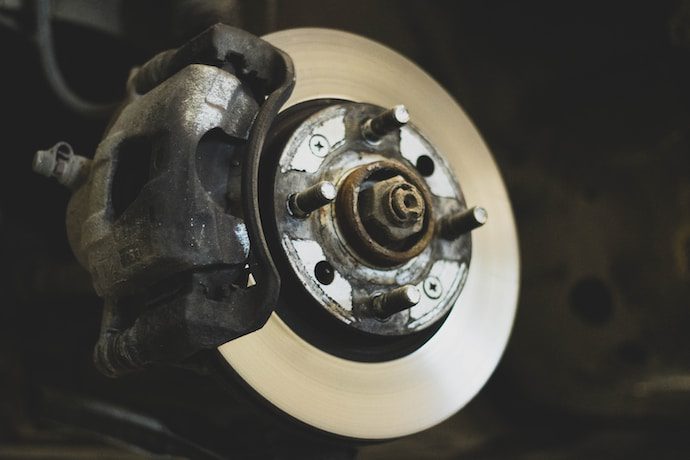
The braking system is one of the most important components of the car. You can’t drive with faulty brakes and expect not to get into accidents. Brakes help decelerate the car and bring it to a complete halt.
However, if you notice that you must press hard to activate the braking system or their grinding noises whenever you apply brakes, then it is time to have your system checked.
The brake pads and rotors take a while before wearing out. However, this is subject to driving styles. If you are a fast driver who brakes hard, expect your brake pads and rotors to wear out ahead of the recommended time. You should learn how brake rotors work before we can tell you when to change them.
How brake rotors work
Brake rotors are circular discs located in each car wheel. They work through a process that converts motion (kinetic energy) into thermal. When you press the brake pedal you activate the braking system.
The calipers on top of the rotors will squeeze the brake pads to the rotors, creating friction. This friction helps slow the car. ABS sensors are often installed in modern cars to inform your onboard computer on the pressure to be applied to the brakes.
This prevents the car from skidding as the sensors control the braking in each wheel. There are different types of brake rotors that you need to be familiar with.
Blank and Smooth brake rotor
This is the most common type of brake rotor for passenger cars. The rotors come in two types – the basic and premium oe-specific rotors. These are a smooth outer braking surface with no drilled slots inside the system.
The basic oe-specific rotors have thicker internal fins and are made from recycled steel. They are great if you do not drive fast and are hard on the brakes.
The downside is the negative impact on the cooling abilities of the rotors. Premium oe-specific rotors are made from ceramic and last longer due to reduced heat production.
Drilled rotors
One of the biggest problems faced in the braking rotors is dissipating excessive heat from friction. Drilled rotors have holes drilled into them that allow for heat dissipation.
The holes also allow the passage of dirt, water, and dust. The rotors are an excellent choice for those who drive frequently in wet areas but are not ideal for high-performance cars.
Slotted rotors
These have various slots engraved on the surface of the rotor. The purpose of the slots is to improve heat dissipation as they draw more air between the rotor surface and the brake pad. The slots are also great for removing any debris on the rotor surface.
Due to the efficient heat dissipation, the slotted rotors are ideal for SUVs, trucks and pickups. They offer excellent braking power when you are doing heavy hauling. The only downside with the slotted rotors is they are not long-lasting and may need frequent replacement.
Drilled and slotted rotors
This is a combination of both slotted and drilled rotors. They work great in heat dissipation, making them ideal for high-performance cars with hard braking.
Symptoms of bad/failing brake rotors
Before changing your braking rotors, knowing the symptoms of failing brake rotors is vital. Driving around in faulty brakes is a disaster in the making.
Noisy brakes
Noisy brakes are one of the symptoms of defective or worn-out motors. Normal braking should be silent and quick. The wearing out becomes uneven as you continue using your braking rotors for an extended time. This means you have some sections raised while others are depressed. These warped rotors are noisy and are a signal for replacement.
Vibrating brakes
Due to the warped brakes, you may experience some form of vibration from the tires the moment you apply the brakes. The vibration can extend to the chassis and the steering wheel making it dangerous to steer the car at high speeds. The reason for the vibration is that the braking pedal is no longer making contact with the rotors.
Increased stopping distance
Once your brakes start wearing out one of the things you will notice is you have an extended braking distance. It takes the car a long time for it to come to a complete halt.
This is exuberated by the increased vibrations as the pedal fails to make contact to with the brake rotor. Driving with such kinds of brakes is extremely dangerous –especially when you are making emergency stops.
Groove marks on the rotors
If you are experiencing the above symptoms the next step is to inspect your braking rotors physically. You will notice that worn-out rotors have grooves on them. Rotors are designed to last long but not for a lifetime. Due to constant friction with the brake pads, they will wear out and develop groove marks or become warped.
When to replace worn-out brake rotors
This is not a direct answer as many factors influence rotor wear. How hard you brake can have an impact on fast rotor wear as well as they type of rotors you are using.
However, most of the braking rotors have a lifespan of around 50,000 to 70,000 miles. The brake pads wear out faster and should be changed after 10,000 to 20,000 miles.
The braking rotors are exposed to a lot of friction, generating a lot of heat. For this, most of the rotors will come with holes drilled into it. These holes or slots are there for heat dissipation and removing dirt and water from the rotors.
If you leave in an area that experiences a lot of rainfall or is constantly wet, expect your rotors to wear out faster than someone who only drives in the city. Such areas necessitate grooved rotors that can act as trenches to drive out the water.
When you start experiencing braking problems, a mechanic must look at the system. The mechanic will know whether to replace the braking pads or the motors.
The market is filled with different braking motors – some basic others premium. The high-performance braking rotors are designed for racing cars due to their high speeds but they wear out faster.
You can also identify a premium braking rotor system within your budget. Ensure that the braking rotors are both durable and wear better. You should expect to spend an average of $500 for brake rotors.
Conclusion
It is almost impossible to drive a car without properly functioning brakes. The braking system will consist of the braking caliper, pads and rotors. Braking rotors are not designed to last a lifetime at some point they do wear out.
When this happens, you will start noticing sounds from your car when you apply brakes. The braking distance will also be extended. A closer observation of the braking rotor will reveal to be warped.
There is not definite period to replace your rotors as the type of rotors and how you drive the car will have a direct effect on premature wear and tear.
Typically, brake rotors will wear out after 50,000 miles while the pads after 20,000 miles. Have your rotors inspected immediately when you notice some noisy sounds.
